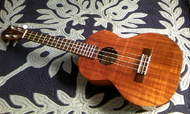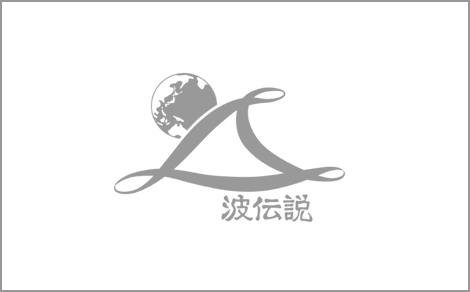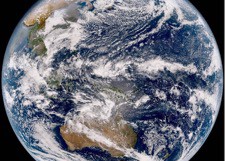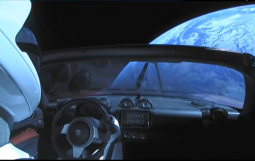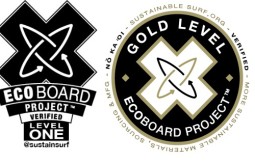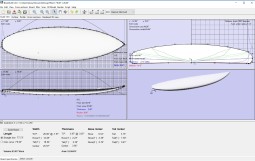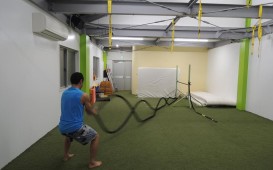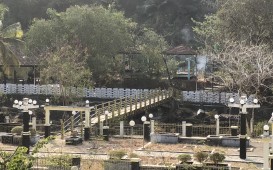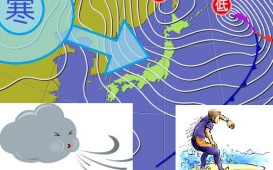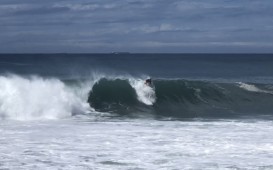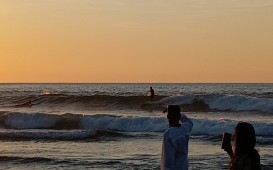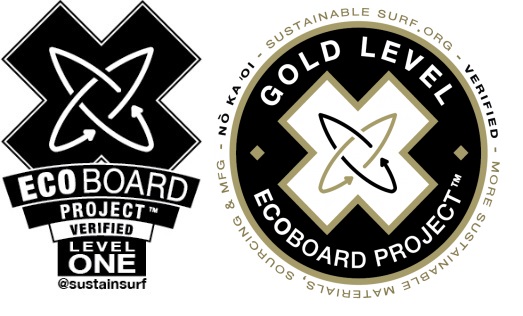
Howzit Howzit…みんな元気?今年の夏は暑すぎた。そんなにたくさんの台風は来なかったけれど、いい波を届けてくれたね。
日に日に寒くなってきているけれど、今年は寒くてもサーフィンを頑張ってみようと思っているんだ・・・たぶんね。冬が近づいている間に、どうすれば暖かくできるか考えているよ。
1.ブーツとキャップを装着する。
2.沖縄へ移るかハワイへ戻るか。
3.スノーボードだけを楽しむか。(笑)
こんなことから、僕は気候変動やサステナビリティについても考えるようになった。
一般的には、天気がどうなるかをよく耳にするけれど、僕が知りたかったことは、海面上昇がサーフブレイクにどのような影響を与えるかということ。
簡単にまとめてあるレポートを見つけたから紹介するね。
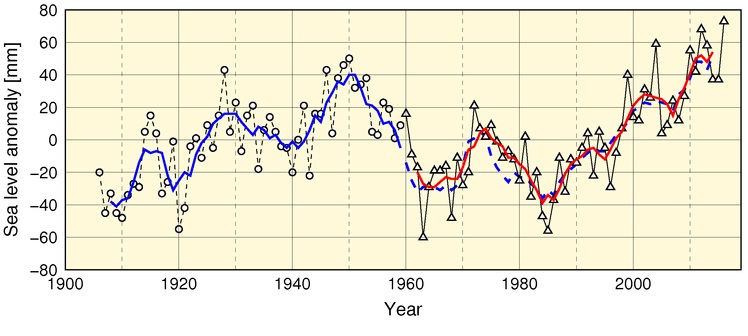
海面水位の時系列 (1906 – 2016)
日本の気象庁によるIPCC(2013年の第5次評価報告書)に基づいた環境影響評価で、年代別に日本の周囲の海面水位を表していて、2016年は世界平均よりも73mm高く、1960年代から最も高くなっているんだ。日本の海面上昇の割合は、1971年から2010年にかけて、1年につき1.1mm、1993年から2010年にかけては2.8mmと上昇が進んでいる。IPCC第4次評価報告書(2007年)では、21世紀の終わりには0.18m~0.59mまで上昇されると見積もられていたものの、森教授を始めとする専門家たちは、その4倍の数値で上昇すると見積もった。
だから、少なくとも0.7mは上昇することを想定しておく必要がある。研究では、1mの海面上昇で日本の90%の砂浜が消えることが明らかになっているんだ。
いずれにせよ、海面上昇は、波のクオリティに徐々に影響を与えると思う。リーフブレイクでは、水深が深くなりすぎて消滅しているポイントもあるほどなんだ。多くのポイントではハイタイドになるとかなり苦しむことになるだろう。
ハイタイドになると良いブレイクが現れる場所では、より岸に近いブレイクとなり、ロータイドが良いポイントでは、一切ブレイクしなくなる。全てのポイントは、「野球場前」から「野球場の上」みたいに変えなければならなくなるだろうね。
科学会のコンセンサスは、「気候変動がまさに起きていて、私たちは最悪の事態になることを食い止める必要がある」と発表した。
それでは、一般市民に何ができるのだろう?気候変動について学び、3R(Reduce:減らす, Reuse:繰り返し使う, Recycle:再生利用する)を実行して環境への負荷を軽減すること。5R(3R+Refuse:断る, Repair:修理する)も加え、さらには7Rとなる日も来るのかな・・・?
サーファーとしては何ができるのか?いつもCO2の排出をどう削減するかを考えておかなければいけないだろう。環境に優しい製品を買うことも大切だね。
「エコボードプロジェクト(2012年発足)」は、CO2排出の削減とリサイクルとアップサイクル(リサイクルした製品の価値をさらに高めること)に焦点を置いている組織で、毒性物質が使われたサーフボードを減らしている。
このプロジェクトは、サーフボードが毒性物質だけでなくCO2の排出によって環境にどれほどの影響を与えるかを教育している。エコボードを採用したメーカーには、環境への影響が少ないことを証明する(アイキャッチ画像の)ラベルをボードに貼ってもらっているんだ。

是非ホームページもチェックしてみて。
http://www.sustainablesurf.org/ecoboard/
それじゃ、環境に優しいボードをゲットして波を捕まえに行こう。サーフショップ、海・山の専門店へのサポートは忘れずに・・・。また次回。…”A hui hou…Malama Pono!!!”
(参照)
森、志村、安田、間瀬教授らによる、北西太平洋の熱帯低気圧が及ぼす影響と気候変動モデルの2013年論文より
The Ecoboard Project
Howzit Howzit…this summer was a blast, not too many typhoons passed but the ones that did brought good waves. It is getting colder now and this year I am going to try and surf more in the cold…maybe. To stay warm while surfing in the coming winter I was thinking of ways to stay warm: 1. Get booties and even a hood, 3. Move to Okinawa or even better return to Hawaii for winter, or 4. Just snowboard…ehehe. For some reason I started thinking about climate change and sustainability. We all hear about how the weather is changing but I wanted to know how would the rise in sea level affect surf breaks. This report is a simple summary of what I found.

Time-series representation of annual mean sea level values (1906 – 2016)
From the JMA assessment that is based on IPCC (5th study, Intergovernmental Panel on Climate Change 2013), the annual mean sea level around Japan in 2016 was 73 mm higher than the normal average, making it the highest since 1960. The rate of rise around Japan was 1.1 mm/year from 1971 to 2010, and 2.8 from 1993 to 2010. IPCC 2007 states the projected rise at the end of the 21st century are between 0.18m and 0.59m but Mori et al. (2013) calculated that the rise should be 4x that amount. So we are looking at a rise of at least 0.7m. Studies show 90% of Japan’s sandy beaches will disappear with a 1m sea-level rise.
In any case, sea level rise will slowly affect surf quality. Reef areas may start to die from the additional water depth. Areas where the surf is highly tide dependent will suffer greatly. Spots that currently breaks good on high tide will in the break further closer to shore if there is a shore and spots that break on low tide will not break at all. The names of all the breaks will need to be changed from “Yakyujo-mae” to “Yakyujo-no-ue”
Consensus in the scientific community is: “climate change is happening and we need to do everything we can to at the worst slow it down.”
What can you do as a world citizen? Learn about climate change and take actions to reduce your environmental footprint through the 3R: Reduce, Reuse, Recycle. And 5R: 3R + Refuse, Repair. In addition wait for the 7R…it may be coming?
What can you do as a surfer? Always be mindful of how to reduce CO2 emissions. Buy products that are environmentally friendly. The Ecoboard Project (started in 2012) is an organization dedicated to focusing on reducing carbon footprints, increasing the use of renewable, recycled and up-cycled products, and reducing the toxic material used in making a surfboard. This project educates about how the surfboard impacts the environment not only with the toxicity but with manufacturing CO2 emissions. They certify makers to affix a label to the board showing the manufacturer reduced environmental impact.

For more information visit: http://www.sustainablesurf.org/ecoboard/
OK…go out, get a new eco-friendly board and go catch a wave. And remember to support your local surf/ocean/mountain activity shop…. Until next time…”A hui hou…Malama Pono!!!
References:
Mori, N., Shimura, T., Yasuda, T. and Mase, H. 2013 Direct projection of future extreme wave climate and influence of tropical cyclone activity in the northwest Pacific Ocean (Ocean Modelling)

